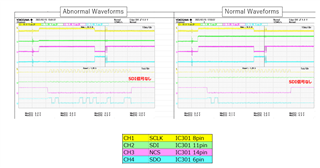Hi team,
Our customer is evaluating TCAN1146-Q1 on their board and they found SDI pin keeps in Low(see "Abnormal Waveforms" below) in communication. The problem solved when they replaced the IC to a new one(see "Normal Waveforms").
What is the possible reason of this issue?

Thank you,
Muwei Zheng

